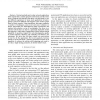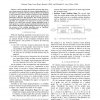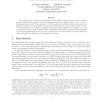SIGMETRICS
2003
ACM
15 years 1 months ago
2003
ACM
It has been observed that the degrees of the topologies of several communication networks follow heavy tailed statistics. What is the impact of such heavy tailed statistics on the...
INFOCOM
2003
IEEE
15 years 1 months ago
2003
IEEE
— Considerable attention has been focused on the properties of graphs derived from Internet measurements. Router-level topologies collected via traceroute-like methods have led s...
FOCS
2003
IEEE
15 years 1 months ago
2003
IEEE
We show that random graphs in the preferential connectivity model have constant conductance, and hence have worst-case routing congestion that scales logarithmically with the numb...
APPROX
2005
Springer
15 years 1 months ago
2005
Springer
We consider the problem of finding a maximum independent set in a random graph. The random graph G, which contains n vertices, is modelled as follows. Every edge is included inde...
INFOCOM
2006
IEEE
15 years 2 months ago
2006
IEEE
— Unstructured p2p and overlay network applications often require that a random graph be constructed, and that some form of random node selection take place over that graph. A ke...
IJCNN
2006
IEEE
15 years 2 months ago
2006
IEEE
Abstract— The incomplete information about the Web structure causes inaccurate results of various ranking algorithms. In this paper, we propose a solution to this problem by form...
SAGA
2007
Springer
15 years 2 months ago
2007
Springer
In the layered-graph query model of network discovery, a query at a node v of an undirected graph G discovers all edges and non-edges whose endpoints have different distance from ...
FOCS
2008
IEEE
15 years 2 months ago
2008
IEEE
A plethora of random graph models have been developed in recent years to study a range of problems on networks, driven by the wide availability of data from many social, telecommu...
APPROX
2009
Springer
15 years 2 months ago
2009
Springer
The r-parity tensor of a graph is a generalization of the adjacency matrix, where the tensor’s entries denote the parity of the number of edges in subgraphs induced by r distinc...
SODA
2010
ACM
15 years 5 months ago
2010
ACM




